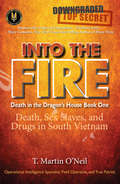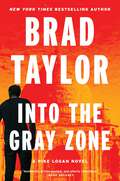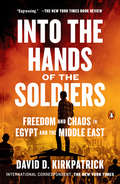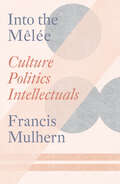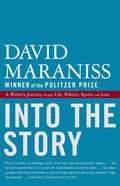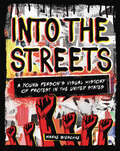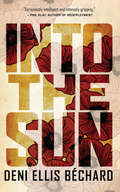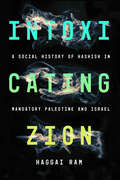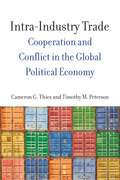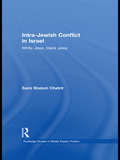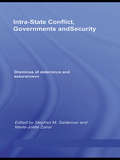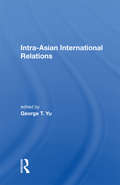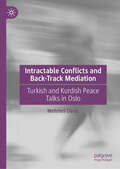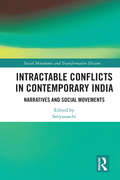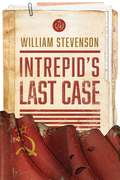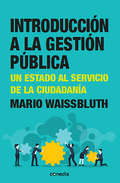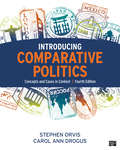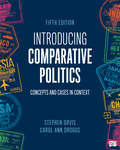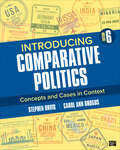- Table View
- List View
Into the Clear Blue Sky: The Path to Restoring Our Atmosphere
by Rob JacksonFrom one of the world&’s leading climate scientists, a heart- and mind-changing book that offers a hopeful and attainable vision for restoring the atmosphere and ending the climate crisis.Climate change is here. From the millions displaced by the floods in Pakistan to Californian and Canadian towns incinerated by wildfires, we are experiencing the anguish that climate change causes. Fossil fuels are making the planet unlivable, and they are deadly. We know that we must cut emissions if we are going to limit the catastrophes, but is that enough? In Into the Clear Blue Sky, climate scientist and chair of the Global Carbon Project Rob Jackson explains that we need to redefine our goals. As he argues here, we shouldn&’t only be trying to stabilize the Earth&’s temperature at some arbitrary value. Instead, we can restore the atmosphere itself in a lifetime—and this should be our moral duty. Restoring the atmosphere means reducing the amount of greenhouse gases in the air to pre-industrial levels—starting with super-potent methane—to heal the harm we have done. Emissions must be cut, first and foremost. But to safeguard a livable planet for future generations, we must repair the damage we have caused. Jackson introduces us to the brilliant leaders and innovators behind some of the boldest and game-changing climate solutions under development. When it comes to greenhouse gas mitigation, our choices matter, because it is easier to stop emissions from happening than to remove greenhouse gases from the air later. But while mitigation is crucial, no number of solar panels, electric cars, and veggie burgers alone will be enough to halt climate change. Decades of inaction have convinced Jackson that we need to remove greenhouse gases from the air using everything from nature to cutting-edge technologies. Into the Clear Blue Sky is a heart- and mind-changing book. Guided by one of the leading scientists in this fight and a deeply gifted storyteller, we learn why we should all feel hopeful. One way or another, we will restore the planet together. The question is how, and how long will it take?
Into the Fire: Death, Sex Slaves, and Drugs in South Vietnam (Death in the Dragon’s House #1)
by T. Martin O’neilThe cover of darkness was pulled back by the NODS scopes in their hands. The enemy had no idea what was about to befall them. With the rush of wings of dragons, the sounds of M-14s, M-870 shotguns, M-16's and grenades spoke the finality of death. This gave the human pack mules a taste of what would continue to reign upon them in the House of the Dragon. North and South Vietnam were at war. Indeed, all of Southeast Asia was at war. Due to national commitments, the U.S. military was drawn into the fray. Members of the elite Navy SEALS performed operations from counter-narcotics, counter-human trafficking and even counter piracy. These men placed their lives on the line daily as true humanitarians. Seen through the eyes of attached Naval Intelligence operatives, their stories can now be revealed. These operations, specific missions, even their love stories, are recounted in Into the Fire.
Into the Gray Zone: A Pike Logan Novel (Pike Logan #19)
by Brad Taylor“A knockout punch of a novel.” —Mark GreaneyPike Logan uncovers a geopolitical scheme that has spiraled out of control in India in this latest pulse-pounding thriller from New York Times bestselling author and former special forces officer Brad Taylor. While on a routine security assessment in India, Taskforce operator Pike Logan foils an attempted attack on a meeting between the CIA and India’s intelligence service. Both government agencies believe it’s nothing more than a minor terrorist attack, but Pike suspects that something much more sinister is at play. After another terrorist operation at the Taj Mahal, he begins to believe that outside powers are attacking India in the gray zone between peace and war, leveraging terrorist groups for nothing more than economic gain. But the separatists conducting the operations have their own agenda.After a massive slaughter and kidnapping of hostages during an elaborate Indian pre-wedding party, two global powers are destabilized, and only Pike Logan and his team can de-escalate the tension by rescuing the captives. What follows is a race against the clock that winds through the bustling markets of Old Delhi, the luxurious resorts of Goa, and the epic halls of the Taj Mahal. It will take everything that Logan and the taskforce have to foil an intricate plot that leaves countless lives in the balance.
Into the Hands of the Soldiers: Freedom and Chaos in Egypt and the Middle East
by David D. KirkpatrickA candid narrative of how and why the Arab Spring sparked, then failed, and the truth about America's role in that failure and the subsequent military coup that put Sisi in power--from the Middle East correspondent of the New York Times.In 2011, Egyptians of all sects, ages, and social classes shook off millennia of autocracy, then elected a Muslim Brother as president. The 2013 military coup replaced him with a new strongman, Abdel Fattah el-Sisi, who has cracked down on any dissent or opposition with a degree of ferocity Mubarak never dared. New York Times correspondent David D. Kirkpatrick arrived in Egypt with his family less than six months before the uprising first broke out in 2011, looking for a change from life in Washington, D.C. As revolution and violence engulfed the country, he received an unexpected and immersive education in the Arab world.For centuries, Egypt has set in motion every major trend in politics and culture across the Middle East, from independence and Arab nationalism to Islamic modernism, political Islam, and the jihadist thought that led to Al Qaeda and ISIS. The Arab Spring revolts of 2011 spread from Cairo, and now Americans understandably look with cynical exasperation at the disastrous Egyptian experiment with democracy. They fail to understand the dynamic of the uprising, the hidden story of its failure, and Washington's part in that tragedy. In this candid narrative, Kirkpatrick lives through Cairo's hopeful days and crushing disappointments alongside the diverse population of his new city: the liberal yuppies who first gathered in Tahrir Square; the persecuted Coptic Christians standing guard around Muslims at prayer during the protests; and the women of a grassroots feminism movement that tried to seize its moment. Juxtaposing his on-the-ground experience in Cairo with new reporting on the conflicts within the Obama administration, Kirkpatrick traces how authoritarianism was allowed to reclaim Egypt after thirty months of turmoil.Into the Hands of the Soldiers is a heartbreaking story with a simple message: The failings of decades of autocracy are the reason for the chaos we see today across the Arab world. Because autocracy is the problem, more autocracy is unlikely to provide a durable solution. Egypt, home to one in four Arabs, is always a bellwether. Understanding its recent history is essential to understanding everything taking place across the region today--from the terrorist attacks in the North Sinai and Egypt's new partnership with Israel to the bedlam in Syria and Libya.
Into the Melée: Selected Essays
by Francis MulhernAn essential collection of literary criticism from Francis Mulhern, author of The Moment of &‘Scrutiny&’ and Culture/MetacultureInto the Melée collects Francis Mulhern's insightful critical writing, much of it in the hybrid literary form that Bagehot described as 'the review-like essay and the essay-like review'. It opens with questions of nationality, from F. R. Leavis's efforts to assert a normatively English literary subject and Ferdinand Mount's exploration of English cultural landscapes to Tom Nairn's political vision of England and Scotland 'after Britain' and Joe Cleary's account of Irish modernism.Another cluster of texts concerns intellectuals and, in one way or another, the politics of revolution and counter-revolution, from Burke to the present. There is an updated sketch of the magazine n +1 as heir to the militant traditions of Partisan Review. What is literature? Sartre's answer was: committed literature.The writer as such was of the left. But culture and politics are discrepant practices, inhabiting one another in permanent tension. In its embrace of provisionality and its magpie curiosity, Mulhern observes, the essay is a mode especially well suited to the purposes of a Marxist criticism morally committed to the value of being surprised.
Into the Story: A Writer's Journey Through Life, Politics, Sports and Loss
by David MaranissOne of the most successful and honored reporter-writers of his day selects pieces that illustrate his own education as a writer.
Into the Streets: A Young Person's Visual History of Protest in the United States
by Marke BieschkeWhat does it mean to resist? Throughout our nation's history, discrimination and unjust treatment of all kinds have prompted people to make their objections and outrage known. Some protests involve large groups of people, marching or holding signs with powerful slogans. Others start with quotes or hashtags on social media that go viral and spur changes in behavior. People can make their voices heard in hundreds of different ways. Join author Marke Bieschke on this visual voyage of resistance through American history. Discover the artwork, music, fashion, and creativity of the activists. Meet the leaders of the movements, and learn about the protests that helped to shape the United States from all sides of the political spectrum. Examples include key events from women's suffrage, the civil rights movement, occupations by Indigenous people, LGBTQ demands for equality, Tea Party protests, Black Lives Matter protests, and more, including the George Floyd protests in the summer of 2020. Into the Streets introduces the personalities and issues that drove these protests, as well as their varied aims and accomplishments, from spontaneous hashtag uprisings to highly planned strategies of civil disobedience. Perfect for young adult audiences, this book highlights how teens are frequently the ones protesting and creating the art of the resistance. "[T]he text never loses sight of the fact that the right to assemble and protest is a basic American right. . . . Highly recommended for middle grade through high school collections in both school and public libraries."—starred, School Library Journal
Into the Sun: A Novel
by Deni Ellis Béchard<P>When a car explodes in a crowded part of Kabul ten years after 9/11, a Japanese-American journalist is shocked to discover that the passengers were acquaintances-three fellow ex-pats who had formed an unlikely love triangle. <P>Alexandra was a human rights lawyer for imprisoned Afghan women. Justin was a born-again Christian who taught at a local school. Clay was an ex-soldier who worked as a private contractor. The car's driver, Idris, was one of Justin's most promising pupils-and he is missing. <P>Drawn to the secrets of these strangers, and increasingly convinced the events that led to the fatal explosion weren't random, the journalist follows a trail that leads from Kabul to Louisiana, Maine, Québec, and Dubai. In the process, the tortured narratives of these individuals become inseparable from the larger story of America's imperial misadventures. <P>In this monumental novel, Deni Ellis Béchard draws an unsentimental portrait of those who flock to warzones, indelibly capturing these journalists, mercenaries, idealists, and aid workers. More importantly, Béchard vividly brings to life the city of Kabul itself, along with the people who live there: the hungry, determined, and resourceful locals who are just as willing as their occupiers to reinvent themselves to survive.
Intoxicating Zion: A Social History of Hashish in Mandatory Palestine and Israel
by Haggai RamWhen European powers carved political borders across the Middle East following World War I, a curious event in the international drug trade occurred: Palestine became the most important hashish waystation in the region and a thriving market for consumption. British and French colonial authorities utterly failed to control the illicit trade, raising questions about the legitimacy of their mandatory regimes. The creation of the Israeli state, too, had little effect to curb illicit trade. By the 1960s, drug trade had become a major point of contention in the Arab-Israeli conflict, and drug use widespread. Intoxicating Zion is the first book to tell the story of hashish in Mandatory Palestine and Israel. Trafficking, use, and regulation; race, gender, and class; colonialism and nation-building all weave together in Haggai Ram's social history of the drug from the 1920s to the aftermath of the 1967 War. The hashish trade encompassed smugglers, international gangs, residents, law enforcers, and political actors, and Ram traces these flows through the interconnected realms of cross-border politics, economics, and culture. Hashish use was and is a marker of belonging and difference, and its history offers readers a unique glimpse into how the modern Middle East was made.
Intoxication: Self, State and Society
by Thomas Thurnell-Read Mark MonaghanWhat images come to mind when you read the word ‘intoxication’? What behaviour do you associate with the word ‘drunk’? When you hear the word ‘drug’, what images do you recall? This textbook provides an essential and thorough grounding in debates about the role of intoxication in contemporary society, from social and cultural perspectives. It examines intoxication in the broadest sense as including both legal and illegal substances and both culturally accepted and socially stigmatised practices. Given the pace of recent changes in policy and practice – from the increasingly common legalisation of cannabis, to the recent trend of sobriety amongst adolescents and young adults – this book stands out by offering both a through historical and theoretical overview and a topical and forward looking exploration of current debates. It adopts a multi-scale approach to examine wider patterns of change so it considers the subjective experiences of the role intoxication plays in the lives of individuals and groups, in the construction of diverse identities and how this differs by age, gender and ethnicity. The authors play particular attention to the way in which the state justifies interventions based on moral, health and criminal justice discourses and also consider the role played by other individuals and institutions, not least the mass media and the alcohol industry, in propagating and challenging common sense explanations of intoxication. It speaks to undergraduates, master's students and above, with a range of pedagogic features, and offers insights into policy and practice.
Intra-Industry Trade
by Timothy Peterson Cameron ThiesIntra-Industry Trade calls for us to rethink what trade most often looks like and how it shapes global institutions, fostering peace among states. Cameron G. Thies and Timothy M. Peterson argue that our understanding of trade has not kept pace with its changing nature in the 21st century; existing models, rooted in Ricardo's theories, regard trade uniformly as taking place between entities and countries that offer different commodities and operate according to the logic of comparative advantage. Though this type of exchange does take place, intra-industry trade--international trade of the same or similar commodities, in which foreign and domestic brands compete--is increasingly prevalent. The authors argue that our current academic and policymaking focus on the total volume of trade, rather than its composition, is misplaced. Trade composition matters, not just because it gives us a fuller understanding of how trade works, but also because intra-industry trade increases the likelihood of positive institutional relations and cooperation between states. To illustrate their point, the authors examine the effects that intra-industry trade has on Preferential Trade Agreement formation, its tendency to lessen World Trade Organization disputes and militarized conflict, and its ability to pave the way for new and fortified alliances.
Intra-Jewish Conflict in Israel: White Jews, Black Jews (Routledge Studies in Middle Eastern Politics)
by Sami Shalom ChetritThis is the first book in English to examine the Mizrahi Jews (Jews from the Muslim world) in Israel, focussing in particular on social and political movements such as the Black Panthers and SHAS. The book analyses the ongoing cultural encounter between Zionism and Israel on one side and Mizrahi Jews on the other. It charts the relations and political struggle between Ashkenazi-Zionists and the Mizrahim in Israel from post-war relocation through to the present day. The author examines the Mizrahi political struggle and resistance from early immigration in the 1950s to formative events such as the 1959 Wadi-As-Salib rebellion in Haifa; the 1970s Black Panther movement uprising; the ‘Ballot Rebellion’ of 1977; the evolution and rise of the SHAS political party as a Mizrahi Collective in the 1980s, and up to the new radical Mizrahi movements of the 1990s and present day. It examines a new Mizrahi discourse which has influenced Israeli culture and academia, and the nature of the political system itself in Israel. This book will be of great interest to those involved in Middle East Studies and Politics, Jewish and Israeli Studies and Race and Ethnic Studies.
Intra-Party Politics and Coalition Governments (Routledge/ECPR Studies in European Political Science)
by Daniela Giannetti Kenneth BenoitThis book explores how intra-party politics affects government formation and termination in parliamentary systems, where the norm is the formation of coalition governments. The authors look beyond party cohesion and discipline in parliamentary democracies to take a broader view, assuming a diversity of preferences among party members and then exploring the incentives that give rise to coordinated party behaviour at the electoral, legislative and executive levels. The chapters in this book share a common analytical framework, confronting theoretical models of government formation with empirical data, some drawn from cross-national analyses and others from theoretically structured case studies. A distinctive feature of the book is that it explores the impact of intra-party politics at different levels of government: national, local and EU. This offers the opportunity to investigate existing theories of coalition formation in new political settings. Finally, the book offers a range of innovative methods for investigating intra-party politics which, for example, creates a need to estimate the policy positions of individual politicians inside political parties. This book will be of interest to political scientists, especially scholars involved in research on political parties, parliamentary systems, coalition formation and legislative behaviour, multilevel governance, European and EU politics.
Intra-State Conflict, Governments and Security: Dilemmas of Deterrence and Assurance (Contemporary Security Studies)
by Stephen M. Saideman Marie-Joëlle ZaharThis volume seeks to understand the central role of governments in intra-state conflicts.The book explores how the government in any society plays two pivotal roles: as a deterrent against those who would use violence; and as a potential danger to the society. These roles come into conflict with each other, as those governments that can best deter
Intra-asian International Relations
by George T. YuThis collection of authoritative papers prepared by some of America's most eminent scholars in the field provides us with an up-to-date analysis of the complex and rapidly changing relations among China, Russia, Japan, and the countries of South and Southeast Asia. The contributors discuss in depth the major issues faced by the policymakers of each country, examining also the role of the U.S. in order to furnish greater perspective and a more realistic picture. Among the issues considered are Sino-Soviet relations, interdependence versus national assertiveness, economic interaction, and the effects of international conflict. The analyses of individual countries are supplemented by a broader view of actors and issues in regional and international contexts; equally important, the emphasis on contemporary aspects allows a look at current trends and the dynamics of future Asian international relations.
Intra-european Student Mobility In International Higher Education Circuits
by Christof Van MolAdopting an interdisciplinary approach, this book empirically investigates the (im)mobility decisions, social network formation, sense of European identity and migratory aspirations of higher education students. It draws on a large-scale survey, in-depth interviews and focus groups, conducted in Austria, Belgium, Italy, Norway, Poland and the UK.
Intractable Conflicts and Back-Track Mediation: Turkish and Kurdish Peace Talks in Oslo
by Mehmet DenizThis book provides an in-depth analysis of mediation, arguing that it represents a vital tool for third-party intervention, and that back-track mediation more specifically, as one of the tools of such intervention, is a pillar of mediation. It further considers the 'Kurdish question' of Turkey and the peace process initiatives between the Turkish state and the Kurdistan Workers’ Party (PKK) from the first in 1993 to the recently-concluded Oslo Peace Talks in 2011. Rather than focusing on the historicity of the Kurdish issue, this book devotes significant attention to analysing the five peace processes to date by investing the theory of mediation in each process with a view to testing whether each initiative fits the essence of mediation and back-track mediation or not. The book additionally considers two issues of secondary importance: the reiteration of the emergence of the ‘Kurdish question’ as a regional phenomenon responsible for derailing the Oslo Peace Talks between the parties, as well as the intractability of conflicts and how they have potential to acquire violent, intractable characters. This monograph applies this theoretical knowledge to consider how Turkish and Kurdish conflicts have gradually morphed into an intractable singular conflict.
Intractable Conflicts in Contemporary India: Narratives and Social Movements
by SavyasaachiThis book attempts a representation of society in contemporary India through an ethnography woven around long-standing intractable conflicts — of displacement and rehabilitation, patriarchy, insurgency and counter-insurgency operations, and climate change. Each chapter in this volume offers a critical transformative narrative in response to these conflicts. It asks how social justice and equality is to be constructed and provides a fresh perspective. It is argued that social movements can no longer be concerned only with itemizing a checklist of demands; it is now necessary to be free of the hegemony of current frames, categories, concepts and principles, and to rethink the ‘promise’. The volume maintains that this effort to step out of the ‘endless waiting’ for delivery of a ‘promised value’ draws out the labour of transformative action. A valuable contribution to understanding social movements in India, this work challenges the established discourses around grassroots politics, progressive policies and legislations as well as radical mass movements. The book will interest students and researchers of social movements, conflict and peace studies, sociology and social anthropology, political science and development studies. It will also be useful to those working in the areas of human rights, social exclusion and inclusive policies.
Intrepid's Last Case (Lyons Press Ser.)
by William StevensonIntrepid's Last Case chronicles the post-World War II activities of Sir William Stephenson, whose fascinating role in helping to defeat the Nazis was the subject of the worldwide bestseller A Man Called Intrepid. Sir William Stephenson (Intrepid) still stood at the center of events when he and author William Stevenson discussed in the 1980s an investigation into sudden allegations that Intrepid's wartime aide, Dick Ellis, had been both a Soviet mole and a Nazi spy. They concluded that the rumors grew, ironically, from Intrepid's last wartime case involving the first major Soviet intelligence defector of the new atomic age: Igor Gouzenko. Intrepid saved Gouzenko and found him sanctuary inside a Canadian spy school. Gouzenko was about to make more devastating disclosures than those concerning atomic espionage when the case was mysteriously terminated and Intrepid's organization dissolved. Unraveling the implications of Gouzenko's defection and Intrepid's removal from the case, tracing the steps of Dick Ellis and disclosing much new information regarding United States and Canadian postwar intelligence activities, Intrepid's Last Case is a story that for sheer excitement rivals the best spy fiction--and is all the more important because every word is true. Filled with never-before-revealed facts on the Soviet/Western nuclear war dance and a compelling portrayal of the mind of a professional spy, Intrepid's Last Case picks up where the first book ended, at the very roots of the cold war. It describes one of the most widespread cover-ups and bizarre betrayals in intelligence history. This is the incredible Intrepid against the KGB.
Introducción a la gestión pública
by Mario WaissbluthUn Estado al servicio de la ciudadanía. Existe un gran número de textos en español respecto a políticas públicas, es decir, el «qué hacer» del Estado en cualquiera de sus esferas. Una vez definido el qué, es necesario responder la pregunta del «cómo hacer», es decir, con qué arreglos institucionales y gestión de sus instrumentos se implementan estas políticas. En este espacio ya no abundan. El propósito de este texto no se refiere al qué, sino al cómo, aun entendiendo que ambas esferas se traslapan siempre en una cierta medida. Como dice su autor, Mario Waissbluth, este libro está dedicado a aquellos directivos públicos, presentes o futuros, que quieran servir a la ciudadanía de los países de América Latina, aún a sabiendas que la tarea es dura, más dura que en el sector privado, aunque con gratificaciones mucho mayores cuando se obtienen resultados. “Introducción a la gestión pública. Un Estado al servicio de la ciudadanía ofrece un aporte indispensable al debate sobre cómo nuestras sociedades pueden contar con instituciones capaces de responder a lasnecesidades y demandas de la gente”. Luis Alberto Moreno, presidente BID.
Introducing Comparative Politics: Concepts and Cases in Context
by Carol Ann Drogus Stephen OrvisOrganized thematically around important questions in comparative politics, Introducing Comparative Politics, Fourth Edition by Stephen Orvis and Carol Ann Drogus integrates a set of extended case studies of 11 core countries into the narrative. Serving as touchstones, the cases are set in chapters where they make the most sense topically—not separated from theory or in a separate volume—and vividly illustrate issues in cross-national context. The book’s organization allows instructors flexibility and gives students a more accurate sense of comparative study. In this edition, a brand new chapter on Contentious Politics covers ethnic fragmentation, social movements, civil war, revolutions, and political violence. New case studies on this topic include the Occupy and Tea Party movements in the US; Zapatista rebellion in Mexico; Boko Haram in Nigeria; and; and revolutions in China and Iran. The chapter on States and Identity has been substantially revised to better introduce students to the concept of identity and how countries handle identity-based demands. Case studies include nationalism in Germany; ethnicity in Nigeria; religion in India; race in the US; gender in Iran; and sexual orientation in Brazil. Content on states and markets, political economy, globalization, and development has all been consolidated into a new Part III of the book, focusing in a sustained way on economic issues.
Introducing Comparative Politics: Concepts and Cases in Context
by Carol Ann Drogus Stephen OrvisOrganized thematically around important questions in comparative politics, Introducing Comparative Politics, Fourth Edition by Stephen Orvis and Carol Ann Drogus integrates a set of extended case studies of 11 core countries into the narrative. Serving as touchstones, the cases are set in chapters where they make the most sense topically—not separated from theory or in a separate volume—and vividly illustrate issues in cross-national context. The book’s organization allows instructors flexibility and gives students a more accurate sense of comparative study. In this edition, a brand new chapter on Contentious Politics covers ethnic fragmentation, social movements, civil war, revolutions, and political violence. New case studies on this topic include the Occupy and Tea Party movements in the US; Zapatista rebellion in Mexico; Boko Haram in Nigeria; and; and revolutions in China and Iran. The chapter on States and Identity has been substantially revised to better introduce students to the concept of identity and how countries handle identity-based demands. Case studies include nationalism in Germany; ethnicity in Nigeria; religion in India; race in the US; gender in Iran; and sexual orientation in Brazil. Content on states and markets, political economy, globalization, and development has all been consolidated into a new Part III of the book, focusing in a sustained way on economic issues.
Introducing Comparative Politics: Concepts and Cases in Context
by Carol Ann Drogus Stephen Walter OrvisOrganized thematically around important questions in comparative politics—who rules? what explains political behavior? where and why?—Introducing Comparative Politics, Fifth Edition, integrates a set of extended case studies of 11 countries that vividly illustrate issues in cross-national context. Serving as touchstones, the cases are placed within the chapters where they make the most sense —not separated from the theory or in a separate volume—helping students make connections between the two earlier in the semester. The book&’s hybrid organization gives students a more holistic view of comparative politics.
Introducing Comparative Politics: Concepts and Cases in Context
by Carol Ann Drogus Stephen Walter OrvisOrganized thematically around important questions in comparative politics—who rules? what explains political behavior? where and why?—Introducing Comparative Politics, Fifth Edition, integrates a set of extended case studies of 11 countries that vividly illustrate issues in cross-national context. Serving as touchstones, the cases are placed within the chapters where they make the most sense —not separated from the theory or in a separate volume—helping students make connections between the two earlier in the semester. The book&’s hybrid organization gives students a more holistic view of comparative politics.
Introducing Comparative Politics: Concepts and Cases in Context
by Carol Ann Drogus Stephen Walter OrvisOrganized thematically around important questions in comparative politics, the Sixth Edition of Introducing Comparative Politics integrates a set of extended case studies that vividly illustrate issues in cross-national context for 11 countries. The cases are placed within the chapters where they make the most sense —not separated from the theory or in a separate volume—helping students make connections between theory and practice earlier in the semester and giving them a more holistic view of comparative politics. This title is accompanied by a complete teaching and learning package. Contact your Sage representative to request a demo. Learning Platform / Courseware Sage Vantage is an intuitive learning platform that integrates quality Sage textbook content with assignable multimedia activities and auto-graded assessments to drive student engagement and ensure accountability. Unparalleled in its ease of use and built for dynamic teaching and learning, Vantage offers customizable LMS integration and best-in-class support. It′s a learning platform you, and your students, will actually love. Learn more. Assignable Video with Assessment Assignable video (available in Sage Vantage) is tied to learning objectives and curated exclusively for this text to bring concepts to life. LMS Cartridge: Import this title’s instructor resources into your school’s learning management system (LMS) and save time. Don′t use an LMS? You can still access all of the same online resources for this title via the password-protected Instructor Resource Site. Learn more.

